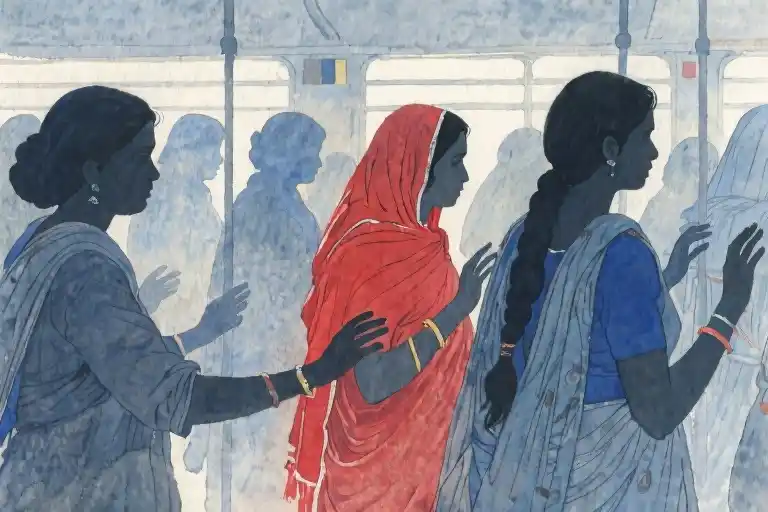Ask any Indian woman what it’s like to grow up in this country, and she won’t start with poetry. She’ll begin with the elbow that pressed too long against her back in last Tuesday’s crowded metro. She’ll mention how her college roommate stopped wearing knee-length dresses after the security guard’s daily comments. She might lower her voice to recount the neighbor who always ‘happens’ to take out his trash when she returns from work.
These aren’t isolated incidents. They’re the unspoken curriculum of being female in India — lessons taught through sideways glances, ‘friendly’ warnings, and hands that linger just a second too long. What gets labeled as women being ‘overly cautious’ or ‘lacking humor’ is often hard-earned survival wisdom, accumulated one uncomfortable moment at a time.
This isn’t about playing victim. It’s about recognizing patterns so ingrained we mistake them for normal. The way girls learn to cross the street when certain groups of men approach. How mothers instinctively position themselves between their daughters and staring strangers. Why office cafeterias see women clustering together like protective constellations.
If you’re a man reading this, resist the urge to dismiss or defend. Just listen. That tension you sometimes feel from female colleagues or relatives? It likely stems from experiences like these:
- The childhood friend who suddenly stopped visiting after his ‘jokes’ turned physical
- That family gathering where uncles debated her marriage prospects like livestock auctioneers
- Every time she pretended to take a phone call walking past construction sites
Gender inequality in India wears everyday disguises. It’s in the aunt who scolds ‘decent girls don’t wear such short sleeves’ while saying nothing to the cousin staring at said sleeves. It’s the boss who assumes the only woman in the meeting will handle refreshments. The rickshaw driver who ‘accidentally’ takes the longer, darker route home.
These stories of everyday sexism don’t make headlines. They’re too common to be news, too mundane to be remarkable — unless you’re the woman calculating whether today’s outfit might ‘invite trouble’ or mapping emergency exits in a new restaurant. What looks like paranoia to outsiders is simply the arithmetic of survival.
So no, Indian women don’t begin their stories with poetry. They start with the unwritten rules we all know but rarely say aloud: Carry your keys between your knuckles after dark. Smile politely at creepy compliments to avoid escalation. Keep one earbud out to hear approaching footsteps. These aren’t overreactions — they’re the reasonable precautions of people who’ve learned what happens when precautions fail.
The miracle isn’t that Indian women navigate this reality with such resilience. It’s that anyone still questions why such resilience is necessary.
This Isn’t About Victimhood: When ‘Adaptation’ Becomes Instinctive
In India, conversations about gender equality often center around statistics and policy debates. But for women living the reality, the story begins much earlier – in the quiet lessons learned through daily survival. The gap between societal claims of progress and lived female experiences forms a chasm wider than most care to acknowledge.
Research from the National Commission for Women reveals Indian girls receive their first safety lectures by age 9 on average. These aren’t abstract discussions, but concrete survival manuals: how to grip keys between fingers when walking alone, the precise angle to hold school bags against groping hands, which clothing choices will attract ‘unnecessary attention.’ By puberty, 78% have already modified behaviors to avoid harassment according to a 2022 UNICEF study.
This early conditioning creates what sociologists term ‘the adaptation paradox’ – women internalize protective behaviors so thoroughly that society mistakes compliance for consent. When a college student maps her route home based on well-lit streets rather than convenience, or when a professional declines after-work drinks citing ‘personal reasons,’ these aren’t personal choices emerging from free will. They’re survival strategies polished through years of practice.
Three key patterns emerge in this socialization process:
- The Normalization of Discomfort
- 63% of women in urban India consider public transportation harassment ‘an expected nuisance’ (ActionAid India)
- “We don’t even register most incidents anymore,” explains Meena, 27, from Delhi. “Like when men press against you in queues – if we reacted every time, we’d never get anywhere.”
- The Burden of Prevention
- 91% of parents teach daughters restrictive behaviors vs 29% who teach sons about consent (NCW 2021)
- “My brother got cricket coaching,” shares Priya, 24. “I got self-defense classes instead.”
- The Camouflage of Compromise
- Working women report spending 17% more mental energy on safety planning than male colleagues (IMRB 2023)
- “I turned down my dream job in Mumbai because the commute involved late nights,” confesses Ananya, 30. “Nobody called it discrimination – even I thought I was being practical.”
This constant adaptation extracts invisible costs. Neurological studies show prolonged vigilance elevates cortisol levels, with working memory capacity dropping by nearly 20% under chronic stress (Journal of Applied Psychology, 2022). The economic toll becomes visible in workforce participation rates – India’s female labor force participation stands at just 24%, among the world’s lowest (World Bank).
Yet labeling this phenomenon as ‘victimhood’ fundamentally misunderstands its nature. “These aren’t helpless reactions,” clarifies Dr. Rekha Sharma, gender psychologist. “They’re highly sophisticated risk-assessment systems women develop to navigate hostile environments. The tragedy isn’t that women adapt – it’s that they must.”
This distinction matters because it shifts the conversation from pity to accountability. When a woman carries pepper spray, she’s not admitting weakness – she’s responding rationally to documented threats. When she avoids public parks at dusk, she’s not being overly cautious but pragmatically interpreting crime statistics. The question isn’t why women take these precautions, but why society continues creating conditions that necessitate them.
That’s why this conversation requires men to ‘stay in the room,’ as the opening challenge suggested. Understanding comes not from debating whether sexism exists, but from witnessing how it operates in these thousand daily concessions. The true measure of gender equality won’t be found in corporate diversity pledges or legal reforms alone, but in the day when Indian women can finally stop adapting to threats that should never have existed.
The Unnoticed Harm: 7 Everyday Scenes of Gender Discrimination
For many women in India, discrimination isn’t an occasional occurrence—it’s the background music of daily life. These experiences shape decisions, behaviors, and worldviews in ways that often go unrecognized by those not facing them. Let’s walk through seven common scenarios where gender inequality manifests in ordinary moments.
1. Public Transportation: The Commute of Constant Vigilance
Every bus ride tells a story. The subtle shift when a woman moves her bag to create a barrier. The calculated decision to stand rather than risk sitting next to certain passengers. The ‘accidental’ touches that never feel accidental at all. Women develop entire strategies for public transit—choosing specific compartments, memorizing safe routes, perfecting the art of the ‘don’t mess with me’ stare. What looks like simple commuting is actually a carefully choreographed safety dance.
2. Family Rules: The Policing of Personal Expression
Remember your first encounter with family dress codes? The aunt who commented on your ‘inappropriate’ knee-length skirt. The uncle who said bright lipstick made you look ‘cheap.’ These aren’t just opinions—they’re early lessons in how society monitors female presentation. Boys get asked about their career plans; girls get reminded to ‘sit properly.’ The message is clear: your body is public property, always subject to approval.
3. Workplace Dynamics: The Invisible Second Shift
Notice who always ends up organizing office parties? Who automatically pours the tea during meetings? These small moments reveal larger patterns. Women frequently shoulder invisible labor—emotional support, social coordination, office housework—that goes unrecognized in performance reviews. Meanwhile, the same assertive behavior that earns male colleagues praise gets labeled ‘bossy’ or ‘difficult’ when coming from women.
4. Street Encounters: The Unwanted Audience
That lingering stare at the market. The car that slows down as you walk. The construction workers’ chorus of whistles. Many women can’t recall when they first noticed being watched—it’s just always been there. This constant surveillance creates what psychologists call ‘ambient awareness,’ a state of low-grade alertness that drains energy but can’t be switched off.
5. Household Decisions: The Myth of Mutual Choice
‘We decided together’ often hides a more complicated reality. From major purchases to vacation plans, women frequently defer to male family members—not from lack of opinion, but from years of being overruled. Even in progressive households, subtle cues (who gets asked first, whose preferences get remembered) reinforce traditional power dynamics. True equality starts when choices stop being defaulted by gender.
6. Education Access: The Silent Rationing
While literacy rates improve, educational discrimination persists in quieter forms. The brother who gets tuition classes while his sister helps with chores. The college application that gets prioritized for male family members. These aren’t always conscious decisions, but they reflect deeply ingrained beliefs about whose future deserves greater investment. Every educational choice shapes entire life trajectories.
7. Digital Spaces: The Endless Inbox
Social media was supposed to democratize voices, but for many women, it’s just another space to manage risk. The unsolicited dick pics. The rape threats in comment sections. The careful self-censorship to avoid attracting trolls. Online harassment forces women to develop digital survival strategies—fake profiles, restricted comments, constant vigilance—that male users rarely need to consider.
These scenes share a common thread: they’ve been normalized to the point of invisibility. But familiarity doesn’t make them harmless. Each ‘small’ incident contributes to what researchers call ‘microtrauma’—the cumulative psychological impact of daily discrimination. Recognizing these patterns is the first step toward changing them.
The Cost of Hyper-Vigilance: When Survival Becomes Exhaustion
For Indian women, constant alertness isn’t a choice—it’s an ingrained survival mechanism with profound consequences. That knot in your stomach when walking past a group of men? The mental map of “safe” routes memorized since adolescence? These aren’t overreactions but learned responses to a world where 84% of women report experiencing public harassment before age 18 (UN Women India, 2022).
The Psychological Toll
Dr. Meera Kulkarni, a Mumbai-based clinical psychologist, describes it as “ambient trauma”:
“Hyper-vigilance operates like a car alarm constantly triggered by false positives. Except for women, these aren’t false alarms—just premature ones. The body stays flooded with cortisol until exhaustion sets in.”
This manifests in:
- Decision fatigue: Calculating risk for routine activities (“Is this skirt too distracting for my 7PM commute?”)
- Social withdrawal: Avoiding gatherings or career opportunities in “unsafe” areas
- Normalized anxiety: 63% of women in urban India consider checking in with friends after dark “basic precautions” rather than excessive worry (NCW Survey, 2021)
The Opportunity Cost
Consider what gets sacrificed at the altar of safety:
- Career trajectories: Tech parks with late-night shifts become non-options
- Educational access: College choices limited by hostel safety ratings
- Financial independence: Ride-hailing apps become budget line items rather than luxuries
A 2023 Oxfam study found working women spend 11% of their income on safety measures (cab fares, pepper sprays, location-sharing apps)—equivalent to the average Indian’s monthly grocery bill.
Breaking the Cycle
The solution isn’t teaching women to be “less paranoid” but creating environments where such vigilance becomes unnecessary. Small shifts matter:
- Men moving to the bus aisle seat without being asked
- Employers auditing workplace commutes as part of HR policy
- Families normalizing sons sharing “safety check” duties for sisters
As Bangalore-based therapist Arjun Patel notes:
“When we pathologize women’s coping mechanisms instead of addressing their causes, we treat the smoke while ignoring the fire.”
This exhaustion has an expiration date—but only when society stops requiring it.
A Guide for Men: From Awareness to Action
Understanding the realities women face is only the first step. Real change happens when awareness translates into concrete actions. Here’s how men can actively contribute to creating safer, more equitable spaces in India.
1. Respect Physical Boundaries in Public Spaces
- On public transport: Maintain a reasonable distance, especially in crowded situations. If you notice a woman adjusting her position to create space, respect that unspoken request.
- In queues/lines: Avoid standing unnecessarily close behind women. That extra 12 inches of space can make someone feel significantly more comfortable.
- Walking at night: If you find yourself walking behind a woman at night, consider crossing the street or slowing your pace to avoid appearing to follow her.
These small adjustments demonstrate awareness of how male presence can be perceived in a society where women constantly assess potential threats.
2. Challenge Problematic Behavior Among Peers
Silence often enables harmful behavior. When you hear friends or colleagues making:
- Sexist jokes
- Victim-blaming comments (“She was asking for it by dressing like that”)
- Objectifying remarks about women
Respond with:
“That’s not cool, man.”
“Would you say that about your sister?”
“Let’s not talk about women that way.”
Research shows that men are more likely to change behavior when called out by other men rather than by women. Your voice matters in shifting social norms.
3. Redistribute Domestic Responsibilities Equally
Gender equality begins at home. Notice where traditional roles might be creating unequal burdens:
- Volunteer to handle grocery shopping, cooking, or cleaning without being asked
- Take equal responsibility for elderly parent care
- Share mental labor (remembering birthdays, scheduling doctor visits)
A 2021 study found Indian women spend nearly 7.5 hours daily on unpaid care work compared to men’s 2.5 hours. Changing this imbalance allows women more time for education, careers, and personal growth.
4. Become an Active Bystander
When you witness potential harassment:
- Assess safety: Only intervene if you can do so without physical risk
- Distract: Ask the woman for directions or the time to disrupt the situation
- Delegate: Alert authorities if needed
- Document: In serious cases, record video evidence (while maintaining safe distance)
5. Educate Yourself Continuously
Recommended resources:
- Books:
- Men Explain Things to Me by Rebecca Solnit
- The Will to Change by bell hooks
- Organizations:
- UN Women India (training programs)
- Men Against Violence and Abuse (MAVA)
- Films:
- Pink (2016 Hindi film about consent)
- Period. End of Sentence. (Oscar-winning documentary)
Small Actions, Big Impact
Change doesn’t require grand gestures. It’s about:
- Not laughing at that sexist meme in the WhatsApp group
- Offering to walk a female colleague to her cab at night
- Teaching your nephew to respect his female classmates
As one gender equality activist noted: “When men start holding other men accountable, that’s when real cultural shift begins.” Your daily choices—what you say, how you act, what you tolerate—collectively shape the environment women experience.
Next steps:
- Pick one action from this list to implement this week
- Share this guide with three male friends
- Reflect on situations where you could have done better (we all have them)
Progress happens one conscious choice at a time. Will you make yours today?
Your Story Matters
Every experience shared is a thread in the larger fabric of change. The stories we’ve discussed — the bus rides, the neighborhood glances, the family comments — aren’t isolated incidents. They’re part of a pattern that needs to be seen, heard, and acknowledged. And your voice can help make that happen.
Why Share Your Story?
- Validation – For every woman who reads these accounts and thinks “I thought it was just me,” your story tells her she’s not alone.
- Education – Many men genuinely don’t understand the cumulative weight of these daily experiences. Personal narratives make abstract concepts concrete.
- Documentation – When we collect these experiences, we create an undeniable record of what’s really happening in our communities.
How to Participate
We’ve created a completely anonymous form where you can:
- Share a specific experience of everyday sexism
- Describe how it made you feel in the moment
- Explain how it changed your behavior long-term
No identifying details are required — not your name, not your city, not even your age unless you choose to include it. This is about the experiences, not the individuals.
What Happens Next
Over the next month, we’ll be:
- Reviewing all submissions (with a team that includes both women and men)
- Selecting representative stories that show the range of experiences
- Compiling them into a digital booklet that will be available for free download
The goal isn’t to shame or blame, but to build understanding. As one reader put it: “When my brother read stories like these, he finally understood why I won’t walk home after dark. Now he offers to pick me up without me asking.”
For Male Readers
If you’re a man hesitating to read these stories, consider this:
- You’re not being accused — you’re being informed
- Discomfort is temporary, but understanding lasts
- The women in your life are probably carrying similar experiences they’ve never shared
As one father wrote after reading such accounts: “I realized I’d been teaching my daughter how to stay safe, but never taught my son how not to be a threat.”
A Closing Thought
Change begins when silent experiences find their voice. Your story — whether it’s about gender inequality in India, everyday sexism, or small moments of progress — adds to that chorus. However you choose to participate, thank you for being part of this conversation.
[Share your story anonymously here]
The Stories We’ll Tell Tomorrow
There’s a quiet revolution brewing in the way Indian women narrate their lives. Not with raised voices or protest signs (though those have their place), but in the subtle rewriting of our collective story. That moment when a daughter asks her father why she can’t ride her bicycle after dark like her brother does. The office meeting where a junior colleague politely declines to fetch chai for the fifth time this week. The college student who wears her black nail polish like armor, daring anyone to comment.
These are the first lines of a new poem we’re writing together – one where safety isn’t a privilege but a right, where vigilance gives way to trust, where our stories might actually begin with poetry after all.
The Ripple Effect of Small Changes
Consider what’s already shifting:
- In homes: Fathers teaching sons to notice when women adjust their dupattas in crowded spaces
- On streets: Men calling out their friends for casual street harassment
- At work: Male colleagues voluntarily rotating tea-serving duties
These aren’t grand gestures. They’re the quiet work of rewriting social codes, one interaction at a time. Like the Bangalore tech worker who started walking between his female colleagues and passing vehicles after dark. Or the Delhi college student who organized a “bike buddy” system for women commuting late from campus.
The Invitation Still Stands
Remember that opening challenge – “try staying in the room”? Here’s what happens when men do:
- 72% of male participants in gender sensitivity workshops report noticing previously invisible discrimination (UN Women India 2022)
- Workplace harassment complaints increase initially – not because incidents rise, but because reporting mechanisms gain trust
- Mixed-gender neighborhood watch programs show 40% faster response to women’s safety concerns
This isn’t about blame; it’s about partnership. When men truly listen to women’s experiences of everyday sexism, something remarkable happens – they start seeing the invisible architecture of gender inequality all around them.
Your Verse in This Story
So we end where we began, but with a crucial difference. That bus incident last week? This time, three passengers spoke up. The aunt’s comment about nail polish? Your cousin laughed it off with “Didi likes it, that’s enough.” The neighbor’s lingering gaze? Your brother casually positioned himself between you two at the next community event.
Change moves at the speed of courage – both the courage to speak and the courage to listen. The question we posed at the beginning now comes full circle:
Will you be the one who helps rewrite this story?
Because someday soon, when a young girl is asked about growing up in India, she might just begin with a line of poetry after all.





